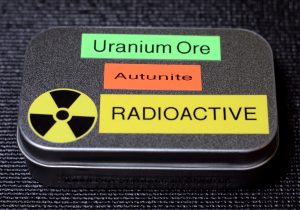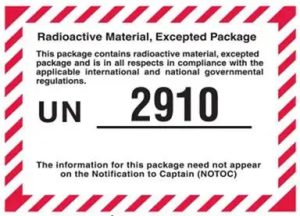Can You Mail Radioactive Materials?
You can mail radioactive material if it’s done by the book and, of course, safely. Here we will concentrate on how to mail radioactive materials that require no special license that one need apply for nor be individually granted such as a raw, unprocessed uranium or thorium ore-containing geological specimen. Note that we are not an official source of information on this topic and things change, so the most foolproof way is to wade through Code of Federal Regulations (CFR) of the Nuclear Regulatory Commission (NRC).

Mailing Radioactive Materials: Raw Geologic Specimens
The scope of this article includes the mailing of a limited amount of raw, unprocessed, geologic ore. Procedures or labeling may differ for other items, even if they are similarly excepted quantities or types of radioactive materials. This may include the UN number displayed or CFR section cited, or other verbiage required by USPS (more on all this below).
NRC Requirements for Mailing Radioactive Materials
The NRC calls radioactive materials “Class 7” materials. In general there are all manner of restrictions, requirements, licenses, papers, containment, and labels involved with this sort of thing. Fortunately, exceptions exist for the lesser extreme materials in limited quantity such as “49 CFR § 173.421 – Excepted packages for limited quantities of Class 7 (radioactive) materials”. This is the one of the keys to legally mailing hobby or educational quantities of radioactive ore.
The NRC requires two main things:
1) The surface activity anywhere on the parcel’s exterior must not exceed .5mrem/hour (0.005 mSv/hour). Since even perfectly calibrated but differently designed Geiger counters and other devices can display vastly different readings due to probe surface area and many other sensitivity factors, we sought what the standard was for measurement. We didn’t want it to be a “pancake” probe but then go using a lesser sensitive tube, ourselves, thereby underestimating what an authority would read. It turned out there was no standard in the CRF. A memorandum buried in Division 8, “Occupational Health,” of the NRC’s Regulatory Guide series and NUREG/CR-5569, “Health Physics Positions Data Base” answered this as a sort of FAQ stating that essentially any reasonable, reliable means is sufficient to determine compliance with surface activity limits (presumably calibrated and certified or certifiable by the NRC). So this indicates a standard beta/gamma “hot dog” probe on a Geiger counter should be sufficient, versus more sensitive probe or device. Just to be safe the author uses an end-window probe with a sensitivity somewhere between the two.
2) “RADIOACTIVE LSA” must be printed visibly somewhere reasonable in relation to the address etc when mailing radioactive materials . Note that carriers may require additional labeling, such as displaying the appropriate UN number (in this case UN2910), but the NRC, itself, requires just this, for packages excepted under 49 CFR 173.41. They are exempt from needing those DOT diamond-shaped transport labels and other things normally required for mailing other radioactive materials.
3) Here’s where things get just a little tricky if you want to go airmail. When mailing radioactive materials, even under these exceptions, air transport is actually prohibited – under one condition – the nature of the package in which it’s contained. 49 CFR § 173.427 (a) (6) (vii) states “Transportation by aircraft is prohibited except when transported in an industrial package in accordance with Table 6 of this section, or in an authorized Type A or Type B package.”
After a couple of tables referring to one another this leads to it needing to be a “Type IP-1” (Industrial Package – Type 1) package. While this, at first, sounded intimidating like something Bruce Willis would be trying to open and disarm, it simply seems to define something reliable not to fall apart (but you be the judge of the code copy/pasted below). After all, if air mail was simply prohibited, a very common air mail label would not exist (available from LabelMaster.com):
IP-1 is defined in below :
49 CFR § 173.410 – General design requirements – skip to section (i) :
(i) For transport by air –
(1) The temperature of the accessible surfaces of the package will not exceed 50 °C (122 °F) at an ambient temperature of 38 °C (100 °F) with no account taken for insulation;
(2) The integrity of containment will not be impaired if the package is exposed to ambient temperatures ranging from −40 °C (−40 °F) to + 55 °C (131 °F); and
(3) A package containing liquid contents must be capable of withstanding, without leakage, an internal pressure that produces a pressure differential of not less than the maximum normal operating pressure plus 95 kPa (13.8 psi).
(end/copy/paste)
If you feel your package is compliant with IP-1 definitions (with your item in them) and it gets returned with an “Airmail of Class 7 Materials is Prohibited – Return to Sender” admonishment, try sending it again with additional labeling stating that it is compliant with 49 CFR § 173.427 (a) (6) (vii) by way of being an IP-1 container thereby allowing its contents to travel by air.
USPS Requirements for Mailing Radioactive Materials
USPS aligns with the NRC’s requirements, but they require a specific statement, below. Other carriers have their own rules but similar or identical. USPS requires:
“RADIOACTIVE” in which case the NRC’s required “RADIOACTIVE – LSA” will suffice
…in addition to (and this can go just underneath RADIOACTIVE – LSA)
This package conforms to the conditions and limitations
specified in 49 CFR 173.421 for radioactive material,
excepted package—limited quantity of material, UN2910,
and is within Postal Service. activity limits for mailing.
Package Size per USPS is stated as:
“No single dimension of the external mailpiece can be less than 2.5 centimeters (1 inch), and the length and girth (combined) can be no less than 30 centimeters (12 inches)”.
It should be noted that it costs about the same to mail a 6x4x4” or 5x5x5” box as it does a compliance-iffy envelope. If you’re doing the wonderfully inexpensive First Class for something under a pound, and it’s likely to go airborne, it may be worth it to go with the box esp. if you’re going to claim it’s package type IP-1 compliant when bearing its particular contents. At least if it’s not going to kill your profit on some low priced nugget, in which case you might want to look more into IP-1 definitions.
Summary for Mailing Radioactive Materials via USPS
1) Parcel surface reads no more than .5mrem/hr.
2) It bears the following:
RADIOACTIVE – LSA
This package conforms to the conditions and limitations
specified in 49 CFR 173.421 for radioactive material,
excepted package—limited quantity of material, UN2910,
and is within Postal Service. activity limits for mailing.
3) If it goes airborne it’s supposed to be a Type IP-1 package to be excepted from being prohibited from air transport
4) It’s good practice to include the airmail label pictured above with the red airmail hashmarks (that’s what those mean – it’s an air mail notice). Some carriers or airlines may require this label for air. It was included in an instruction set a private business had in an employee manual the NRC showed as a good example for shipping FedEx.
